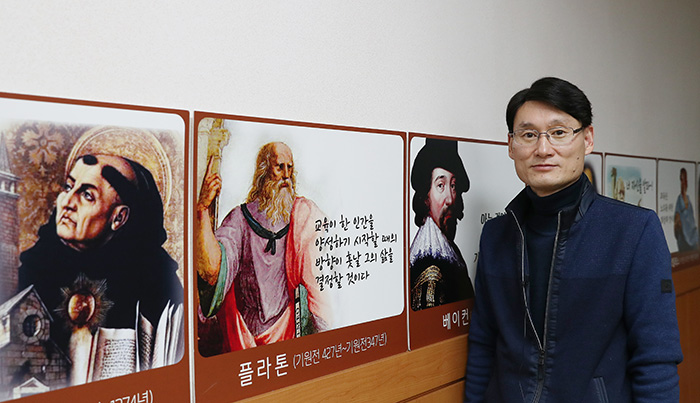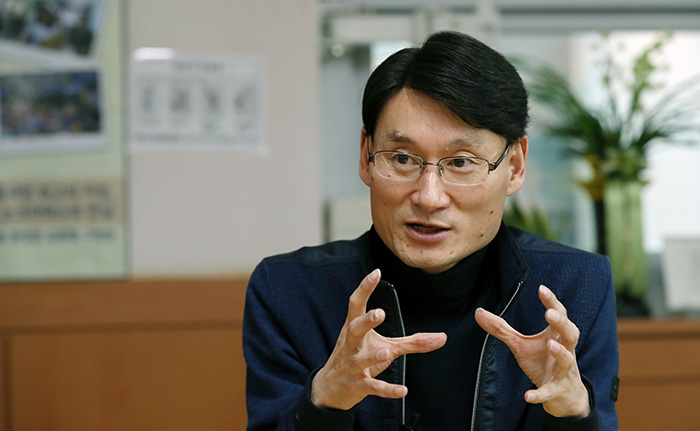Seoul’s Gwanak-gu District provides lectures on a range of liberal art subjects, such as history, library science, mythology, travel and movies, with the goal of enriching the lives of its residents.
Han Jeong Joo, a historian, a scholar of Korean classics and the author of many Korean history books, spoke on the theme of “Seoul, a Trip Into the Past” at Gwanak-gu’s Lifelong Learning Center on Feb. 13.

The topic of his lecture was the ho pennames (호, 號) adopted by Joseon scholars, about which he has written a book.
At the beginning of the lecture, he said that analyzing a scholar's penname, or ho, could lead to insights about the scholar's thoughts and life, and, finally, into the history of Joseon (1392-1910) itself.
According to Han, there were eight types of ho that a scholar could choose. The penname could refer to a place of which they were fond, it could be the name of one of their belongings, it could represent a value that they pursued, it could represent a stage in their life, it could refer to an aspect of their appearance, it could echo the name of one of their respected role models, it could represent their occupation, or it could be a phrase from a classical text that they admire.

Korea.net sat down with Han Jeong Joo to talk about the lives and society of Joseon-era scholars.
Gwanak-gu District provides many other lectures, other than “Seoul, a Trip Into the Past,” all provided at Gwanak-gu’s Lifelong Learning Center throughout the year.
More information can be found at Gwanak-gu’s website (http://www.gwanak.go.kr/) .
By Kim Young Shin
Korea.net Staff Writer
Photos: Jeon Han Korea.net Photographer
ysk1111@korea.kr
Han Jeong Joo, a historian, a scholar of Korean classics and the author of many Korean history books, spoke on the theme of “Seoul, a Trip Into the Past” at Gwanak-gu’s Lifelong Learning Center on Feb. 13.

Han Jeong Joo, a Korean history and classics specialist, delivers a lecture on the names adopted by Joseon scholars, at the Gwanak-gu Lifelong Learning Center on Feb. 13.
The topic of his lecture was the ho pennames (호, 號) adopted by Joseon scholars, about which he has written a book.
At the beginning of the lecture, he said that analyzing a scholar's penname, or ho, could lead to insights about the scholar's thoughts and life, and, finally, into the history of Joseon (1392-1910) itself.
According to Han, there were eight types of ho that a scholar could choose. The penname could refer to a place of which they were fond, it could be the name of one of their belongings, it could represent a value that they pursued, it could represent a stage in their life, it could refer to an aspect of their appearance, it could echo the name of one of their respected role models, it could represent their occupation, or it could be a phrase from a classical text that they admire.

According to Joseon specialist Han Jeong Joo, a scholar's choice of penname, or ho, reveals their thoughts, will or goals, and expresses what kind of person they were.
Korea.net sat down with Han Jeong Joo to talk about the lives and society of Joseon-era scholars.
|
-What is a ho penname (호, 號) and what does it have to do with us today? A typical Joseon scholar had at least three names. The myeong was the name given to them when they were born (명, 名). The ja was the name given after coming-of-age (자, 字). Finally, the ho was the name that expressed their own mind and thoughts (호, 號). In a modern sense, the ho is similar to a nickname. Unlike given names, one can occupy multiple hos, so to speak, that express one’s thoughts, wills, goals or ideologies. It's a means of revealing what’s within. Even today, it can be a way to express oneself and to appeal to others. -Whose ho is the most memorable for you? Personally, I find the name Eoudang (어우당, 於于堂) to be interesting. That is the ho of Yu Mong-in (유몽인, 柳夢寅) (1559-1623), the author of the "Eouyadam" (어우야담, 於于野譚), a collection of stories. The name means “to delude people with nonsense.” What he wrote was unacceptable to his contemporaries. It was unbelievable for them to see an aristocrat write about unofficial myths as told by the commoners. His penname, paradoxically, reveals that he didn't mind such criticisms. -During your lecture, you mentioned that there were pennames based on the name of places. Could you tell us about one, please? Jeong Yak-yong (정약용, 丁若鏞) (1762-1836), was known by his famous penname Dasan (다산, 茶山), but he also called himself Yeoyudang (여유당, 與猶堂). This was also the name of his residence compound in Namyangju-si, Gyeonggi-do Province. It means “to be careful as if stepping on a thin layer of ice and to be alert as if someone is watching the whole time." After King Jeongjo (정조, 正祖) died, Jeong’s political faction was pushed into a political corner. His ho shows the way he viewed his life ahead. -Where can we find more traces of Joseon scholars? There are some places that are described in old texts that stir one's imagination. The Segumjeong Pavillion (세검정, 洗劍亭) is one such place. Jeong Yak-yong wrote about it in one of his poems, "Yusegeomjeonggi" (유세검정기, 游洗劍亭記), which is a record of times he enjoyed at the pavilion with his friends. During the rainy season in the summer, his group would usually stay around the capital and head out to the pavilion to drink. A flooded stream would flow in front of the Segumjeon Pavilion during the rainy season. People who sat there enjoyed the splash of water from the stream. However, the place is now developed and no longer floods. Unfortunately, many of the cultural assets in central Seoul have been destroyed due to modernization and urbanization. However, there are some left outside of Seoul. For example, places related to famous Joseon scholar Yi Yi (이이, 李珥) (1536-1584), such as the Hwaseokjeong Pavilion and the Jaunseowon Confucian Academy, are still intact in Namyangju, Gyeonggi-do Province. -A show about Yi Yi’s mother, Shin Saimdang (신사임당, 申師任堂) (1504-1551), is currently on TV. What are your thoughts about the mother-son pair? Yi Yi, also known by his ho of Yulgok (율곡, 栗谷), lost his mother when he was 16-years-old. He couldn't recover from the shock until he was 19-years-old and decided to become a Buddhist monk. According to legend, the monks praised the boy as a living saint when he joined them at a shrine at the Geumgangsan Mountains because he had attained the Truth, which even the older monks couldn't attain. Even at his young age, his understanding of philosophy was extraordinary. After a year, he returned to the secular world and wrote the "Jagyeongmun" (자경문, 自警文), a list of his life-long goals. The first on the list was to live by the standards of earlier Confucian scholars, and his life wasn't complete until he fulfilled them all. What made him set such high standards -- not simply passing the government civil service exam or rising to become a high-ranked governor -- is likely his mother’s education. Yulgok didn't call anyone his teacher except for his mother. The mother’s ho, Saimdang (사임당, 師任堂), shows that her role model was Tai Ren (태임, 太妊), the mother of King Wen of Zhou (주나라 문왕, 周文王) (1152 B.C.-1056 B.C.), one of the Confucian saints . I believe that learning from his mother was such a huge inspiration for him that it led him to study a lot in his early years. -Recently, you published “Reading Lee Duk-mu, the Best Joseon Writer." What makes Lee Duk-mu so noteworthy? Lee Duk-mu (이덕무, 李德懋) (1741-1793) was a scholar, but he was a peculiar one. Confucian scholars had to follow certain rules when writing. The content had to be based on earlier scriptures and styles. However, he didn't follow the rules. Also, he was dedicated to building an encyclopedic knowledge, and reading books that had nothing to do with Confucianism. He was certainly different from other scholars before him. -You wrote many books about different topics in Korean history. What's your next book about? I’m planning to write about Joseon cuisine in the 1700s. In many ways, it's hard to tell whether certain things are actually original or if they've been altered. To determine whether or not something's authentic or whether it's been affected by non-Korean information or sources, texts from pre-modern and modern times need to be compared. I'm focusing on the 1700s because records from that time leave the most evidence from pre-modern times. It's that century that bridges the pre-modern and modern times. |
Gwanak-gu District provides many other lectures, other than “Seoul, a Trip Into the Past,” all provided at Gwanak-gu’s Lifelong Learning Center throughout the year.
More information can be found at Gwanak-gu’s website (http://www.gwanak.go.kr/) .
By Kim Young Shin
Korea.net Staff Writer
Photos: Jeon Han Korea.net Photographer
ysk1111@korea.kr